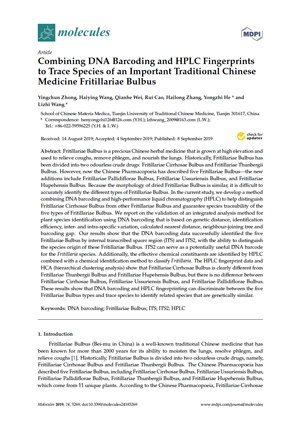NEWS 2019
Combining DNA Barcoding and HPLC Fingerprints to Trace Species of an Important Traditional Chinese Medicine Fritillariae Bulbus
Yingchun ZHONG, Haiying WANG, Qianhe WEI, Rui CAO, Hailong ZHANG, Yongzhi HE, Lizhi WANG
Molecules 24(18), 3269 (2019)
https://doi.org/10.3390/molecules24183269
School of Chinese Materia Medica, Tianjin University of Traditional Chinese Medicine, Tianjin 301617, China
Abstract
Fritillariae Bulbus is a precious Chinese herbal medicine that is grown at high elevation and used to relieve coughs, remove phlegm, and nourish the lungs. Historically, Fritillariae Bulbus has been divided into two odourless crude drugs: Fritillariae Cirrhosae Bulbus and Fritillariae Thunbergii Bulbus. However, now the Chinese Pharmacopoeia has described five Fritillariae Bulbus—the new additions include Fritillariae Pallidiflorae Bulbus, Fritillariae Ussuriensis Bulbus, and Fritillariae Hupehensis Bulbus. Because the morphology of dried Fritillariae Bulbus is similar, it is difficult to accurately identify the different types of Fritillariae Bulbus. In the current study, we develop a method combining DNA barcoding and high-performance liquid chromatography (HPLC) to help distinguish Fritillariae Cirrhosae Bulbus from other Fritillariae Bulbus and guarantee species traceability of the five types of Fritillariae Bulbus. We report on the validation of an integrated analysis method for plant species identification using DNA barcoding that is based on genetic distance, identification efficiency, inter- and intra-specific variation, calculated nearest distance, neighbour-joining tree and barcoding gap. Our results show that the DNA barcoding data successfully identified the five Fritillariae Bulbus by internal transcribed spacer region (ITS) and ITS2, with the ability to distinguish the species origin of these Fritillariae Bulbus. ITS2 can serve as a potentially useful DNA barcode for the Fritillaria species. Additionally, the effective chemical constituents are identified by HPLC combined with a chemical identification method to classify Fritillaria. The HPLC fingerprint data and HCA (hierarchical clustering analysis) show that Fritillariae Cirrhosae Bulbus is clearly different from Fritillariae Thunbergii Bulbus and Fritillariae Hupehensis Bulbus, but there is no difference between Fritillariae Cirrhosae Bulbus, Fritillariae Ussuriensis Bulbus, and Fritillariae Pallidiflorae Bulbus. These results show that DNA barcoding and HPLC fingerprinting can discriminate between the five Fritillariae Bulbus types and trace species to identify related species that are genetically similar.




